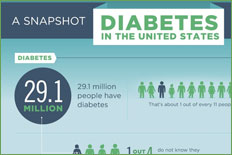Health Centers > Diabetes Center > The Hypoglycemic States
The Hypoglycemic States
Introduction
Spontaneous hypoglycemia in adults is of two principal types: fasting and postprandial. Symptoms begin at plasma glucose levels in the range of 60 mg/dL and impairment of brain function at approximately 50 mg/dL. Fasting hypoglycemia is often subacute or chronic and usually presents with neuroglycopenia as its principal manifestation; postprandial hypoglycemia is relatively acute and is often heralded by symptoms of neurogenic autonomic discharge (sweating, palpitations, anxiety, tremulousness).
Diabetic Coma
Diabetic Ketoacidosis
Hyperglycemic Hyperosmolar state
Lactic Acidosis
The Hypoglycemic StatesIntroduction
Hypoglycemia due to Pancreatic B cell tumors
Persistent Islet Hyperplasia(NonInsulinoma Pancreatogenous Hypoglycemia Syndrome)
Hypoglycemia Due to Extrapancreatic Tumors
Postprandial Hypoglycemia (Reactive Hypoglycemia)
Alcohol-Related Hypoglycemia
Factitious Hypoglycemia
Immunopathologic Hypoglycemia
Drug-Induced Hypoglycemia
Differential Diagnosis
Fasting hypoglycemia may occur in certain endocrine disorders, such as hypopituitarism, Addison's disease, or myxedema; in disorders related to liver malfunction, such as acute alcoholism or liver failure; and in instances of renal failure, particularly in patients requiring dialysis.
Clinical Findings
These conditions are usually obvious, with hypoglycemia being only a secondary feature. When fasting hypoglycemia is a primary manifestation developing in adults without apparent endocrine disorders or inborn metabolic diseases from childhood, the principal diagnostic possibilities include (1) hyperinsulinism, due to either pancreatic B cell tumors or islet hyperplasia or surreptitious administration of insulin (or sulfonylureas), and (2) hypoglycemia due to non-insulin-producing extrapancreatic tumors.
Postprandial (reactive) hypoglycemia may be classified as early (within 2-3 hours after a meal) or late (3-5 hours after eating). Early, or alimentary, hypoglycemia occurs when there is a rapid discharge of ingested carbohydrate into the small bowel followed by rapid glucose absorption and hyperinsulinism. It may be seen after gastrointestinal surgery and is particularly associated with the dumping syndrome after gastrectomy. In some cases, it is functional and may represent overactivity of the parasympathetic nervous system mediated via the vagus nerve. Rarely, it results from defective counterregulatory responses such as deficiencies of growth hormone, glucagon, cortisol, or autonomic responses.
Alcohol-related hypoglycemia is due to hepatic glycogen depletion combined with alcohol-mediated inhibition of gluconeogenesis. It is most common in malnourished alcohol abusers but can occur in anyone who is unable to ingest food after an acute alcoholic episode followed by gastritis and vomiting.
The Hypoglycemic States
Spontaneous hypoglycemia in adults is of two principal types: fasting and postprandial. Symptoms begin ...
Diabetes Complications
The major cause of the high morbidity and mortality rate associated with...
Chronic Complications of Diabetes
Late clinical manifestations of diabetes mellitus include a number of pathologic changes ...
Diabetes Cardiovascular complications
Cardiovascular disease risk is increased in patients with type 1 diabetes...
Complications of Insulin Therapy
Hypoglycemic reactions, the most common complication of insulin therapy...
Diabetic Nephropathy
As many as 4000 cases of end-stage renal disease occur each year among diabetic people in the United States...
Diabetic Neuropathy
Diabetic neuropathies are the most common complications of diabetes affecting...
Immunopathologic hypoglycemia is an extremely rare condition in which anti-insulin antibodies or antibodies to insulin receptors develop spontaneously. In the former case, the mechanism appears to relate to increasing dissociation of insulin from circulating pools of bound insulin. When antibodies to insulin receptors are found, most patients do not have hypoglycemia but rather severe insulin-resistant diabetes and acanthosis nigricans. However, during the course of the disease in these patients, certain anti-insulin receptor antibodies with agonist activity mimicking insulin action may develop, producing severe hypoglycemia.
Factitious hypoglycemia is self-induced hypoglycemia due to surreptitious administration of insulin or sulfonylureas.
Daily Diabetes News
Rice study details stress-diabetes link
That control lies with the brain’s executive functions, processes that handle attention, inhibition, working memory and cognitive flexibility and are also involved in reasoning, problem-solving and planning.
The study…


